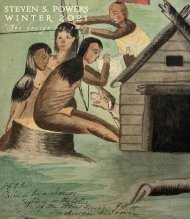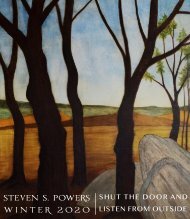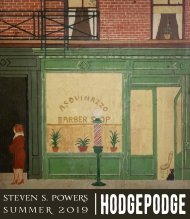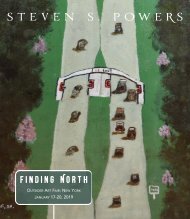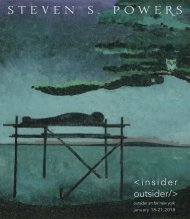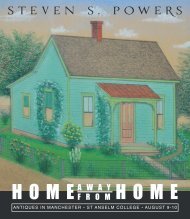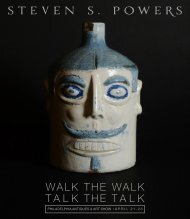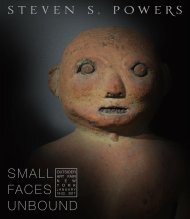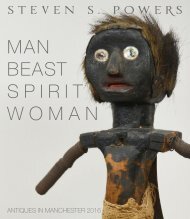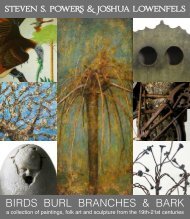NEEDLE • KNIFE • TORCH [&] BRUSH
Steven S. Powers presents, NEEDLE • KNIFE • TORCH [&] BRUSH, a collection of Outsider, Folk Art and good ol' Americana assembled for exhibition and sale at The Philadelphia Antiques & Art Show April 15-17 2016 with a gala preview party April 14. The Navy Yard, Marine Parade Grounds, Philadelphia, PA 19112. StevenSPowers.com for more information.
Steven S. Powers presents, NEEDLE • KNIFE • TORCH [&] BRUSH, a collection of Outsider, Folk Art and good ol' Americana assembled for exhibition and sale at The Philadelphia Antiques & Art Show April 15-17 2016 with a gala preview party April 14. The Navy Yard, Marine Parade Grounds, Philadelphia, PA 19112. StevenSPowers.com for more information.
Create successful ePaper yourself
Turn your PDF publications into a flip-book with our unique Google optimized e-Paper software.
THE PHILADELPHIA ANTIQUES & ART SHOW 2016
S T E V E N S . P O W E R S<br />
N E E D L E<br />
K N I F E<br />
T O R C H<br />
[ & ]<br />
B R U S H<br />
Assembled for exhibition and sale at The Philadelphia Antiques & Art Show<br />
April 15-17 2016 with a gala preview party April 14.<br />
The Navy Yard, Marine Parade Grounds, Philadelphia, PA 19112<br />
show website: philadelphiaantiquesandartshow.com<br />
W O R K S O F<br />
A R T<br />
& a m e r i c a n a<br />
360 Court Street #28, Brooklyn, NY 11231 | 718.625.1715 or 917.518.0809 | stevenspowers.com | member: ADA
Following are three remarkable<br />
embroideries by Joseph Roth, a<br />
schizophrenic patient at the<br />
Central Islip Psychiatric Center,<br />
NY 1905.<br />
At least eleven works by Roth<br />
have been identified, ranging in<br />
date from 1905-1921. The<br />
earlier ones while he was in<br />
Central Islip and then later<br />
when he was a patient at the<br />
Binghamton State Hospital.<br />
Roth and these works are an<br />
important addition to the canon<br />
and study of American Outsider<br />
Art.<br />
They are written in broken<br />
English and German, without<br />
punctuation and only in capital<br />
letters. Some are highly<br />
illustrative, while others, like<br />
the examples herein are more<br />
focused on the written word.<br />
Joseph Roth<br />
Kalane.Sunday.August.27.1905..Report<br />
Embroidered thread on linen<br />
Dated: August 27, 1905<br />
Size: 10 3/8" (w) x 16 1/16" (h)<br />
As of now, I have not been able<br />
to identify Roth, however it can<br />
be inferred that he was likely a<br />
German immigrant and that he<br />
was institutionalized for<br />
schizophrenia and having a<br />
“messiah complex.” On four<br />
embroideries Roth declares that<br />
he is the, “World Erloser”<br />
which translates from German<br />
as “savior or redeemer.”<br />
In trying to find Joseph Roth, I<br />
found that the New York Times<br />
and other papers reported in<br />
May of 1902 that a “Joseph<br />
Roth” a butler, was wanted for<br />
check fraud. It may be a
coincidence, but on several occasions Roth mentions money<br />
and the Homer Lee Banknote Company. Given these interests,<br />
artistic talent and his unstable mind, the fraud may be tied to<br />
this Joseph Roth.<br />
At the turn of the 19thC and into the 20thC, institutions began<br />
using arts and crafts as occupational therapies—embroidery<br />
was one such craft. In thinking of the patience required for<br />
such involved and ambitious works, one can see how<br />
embroidery would slow down ones racing thoughts. One<br />
cannot frenetically scribble their mad rambling words—the<br />
deliberate action of threading the needle, pushing it through<br />
the obverse and reverse, step and repeat, forces one to<br />
consider their thoughts at a more manageable pace.<br />
It is during this time that we see embroideries and other<br />
artistic creations documented in Europe—most famously by<br />
Dr. Hans Prinzhorn, a German psychiatrist and art scholar.<br />
Because of the materials used, Roth’s work draws comparison<br />
to the work of Lorina Bulwer (1838–1912) who was a British<br />
needleworker and a patient at the Great Yarmouth Workhouse.<br />
Bulwer created embroideries with illustrations and copy also<br />
written all in capital letters and without punctuation to<br />
express her anger at her situation. Agnes Richter (1844-1918)<br />
a patient in a German insane asylum obsessively embroidered<br />
her straight jacket. Roth’s work also conjures up the colorful<br />
and obsessive drawings of Adolf Wölfli (1864-1930) of the<br />
Waldau Clinic in Bern, Switzerland, as well as James Edward<br />
Deeds, Jr. (1908-1987) who was in State House #3 in Missouri.<br />
The textile on the previous page is the earliest recorded and<br />
dates from August 27, 1905. It is entitled, the “REPORT.” It<br />
begins with name of Dr. West (who Roth refers to several<br />
times) and lists a number of vocations; Brikleker (bricklayers),<br />
Stonemeson (stonemason), Sourbuilthers (sewer builders), etc.<br />
Roth then declares that he wants to go into NYC with Dr. West<br />
to the Homer Lee Banknote Company. It ends by Roth stating<br />
that he wants to see President Roosevelt in Washington<br />
[about] “the gold and silver money mashinry [sic].” And signs<br />
the textile, “Joseph Roth = World Erloser (world savior).” Note<br />
that not only does he refer to himself as the redeemer; he<br />
decidedly uses the equals (=) sign!
“THE GOLD AND SILVER<br />
MONEY MACHINERY.”<br />
—JOSEPH ROTH<br />
Joseph Roth<br />
Central Islip.Kalane.Den.10.September=1905<br />
Embroidered thread on linen<br />
Dated: September 10, 1905<br />
Size: 14 5/8" (h) x 25" (w)
As mentioned above Roth appears obsessed with money—note<br />
the composition of the following two large textiles—they are<br />
composed as bills, banknotes or bonds with a central<br />
illustrative devise flanked by copy.<br />
The embroidery above is quite rich and complex. Dated<br />
September 10, 1905 (less than two weeks after the “Report.”)<br />
it begins, as one would start a letter, “Dear Father, first of all,<br />
heart felt greetings to you. I am longingly waiting for my<br />
freedom.” Was he committed against his will? Was there an<br />
incident? Roth continues recalling an event of May 18 and his<br />
“heathen” doctor and how he saw his bride, whom he did not<br />
recognize. Roth again mentions President Roosevelt and “the<br />
State House wherein lies millions of dollars of tax money from<br />
the War of 1866 [the Austro-Prussian War].”<br />
Roth continues that he wishes to celebrate his wedding and<br />
hold his “first big sermon” on a trip around the world.<br />
The center is headed with two American flags and a seal of<br />
New York along with eight portraits, four of which are<br />
identical (his bride). Others are the superintendent, Dr.<br />
Marcus B. Heyman (Heiman [sic]), his Mother, the ship’s<br />
captain and possibly a self-portrait.<br />
The textile to the right is dated, November 6, 1905 and as the<br />
above was a letter to his father, this one is a letter to his<br />
brother. “Dear brother, it is hard to be suffering for such a long<br />
time under the weeds, but as soon as I am free, I will be Lord<br />
and Master of the earth.”<br />
Roth’s work is an important addition to American Outsider Art<br />
and his story is fascinating—and with more study and as more<br />
works are discovered or identified, the more fascinating his<br />
story will become.
“...AS SOON AS I AM<br />
FREE, I WILL BE LORD<br />
AND MASTER OF THE<br />
EARTH.” —JOSEPH ROTH<br />
Joseph Roth<br />
Central Islip.Den.6.November=1905<br />
Embroidered thread on linen<br />
Dated: November 6, 1905<br />
Size: 12 7/8" (h) x 24 1/2" (w)
A Record 1300 Words by John F. Ritter<br />
micro-writing, pen and ink on a penny postcard<br />
Circa: October 22, 1902<br />
Size: 3 1/4" (w) x 5 1/2" (h)<br />
Mysterious Four Armed Girl Folk Art Doll<br />
Carved wood & polychrome<br />
Circa: 1880<br />
Size: 9" (h) x 4" (w) x 2 3/4" (d)<br />
Provenance: Marvill Collection<br />
Illustrated and discussed in American<br />
Vernacular, page 126.
John David Wissler<br />
“My passion has always been the landscape. I feel a sense of<br />
history when painting… the painters I admire and study, Corot,<br />
Constable, Turner, Inness, Bonnard, Resika…the history of the land<br />
itself and my own familiar connection to it. Painting comes through<br />
the study of nature…transformed, not merely copied. Seeing the<br />
immediacy of the place…what strikes me first. The way trees react<br />
to fields, colour to colour, shape to shape…pushing and pulling the<br />
plastic nature of the picture plane, creating believable space.<br />
I find the challenge of using what I have observed, taking it to my<br />
studio, and creating a new painting invigorating. Drawing upon the<br />
memory of place and experience…using the language, I have<br />
learned from nature, trying to keep the painting fresh…space,<br />
clarity, surprise…that’s painting!”<br />
—John David Wissler
John David Wissler (1963 -)<br />
Recovering Cold<br />
Oil on board<br />
2012<br />
Size: 12 1/2" (h) x 12 7/8" (w)<br />
Exhibited: Julio Fine Arts Gallery, Loyola University
John David Wissler (1963 -)<br />
Frozen Project<br />
Oil on board<br />
2015<br />
Size: 11 3/4" (w) x 13 7/8" (h)
John David Wissler (1963 -)<br />
Thicket<br />
Oil on board<br />
2013<br />
Size: 9" (h) x 12" (w)
New England Small Red Painted<br />
Wall Box with Symmetrically<br />
Scalloped Back<br />
Circa: 1780<br />
Size: 7" (w) 7 1/4" (h) x 4 3/4" (d)
Exceptional Paint Decorated New<br />
England Traveler’s Mirror with<br />
Carved Shell<br />
Circa: 1730-1750<br />
Size: 6 1/2" (h) x 3 11/16" (w)<br />
German Wrought Iron<br />
Lever - Serpent with<br />
Crown and Apple<br />
Circa: 16thC - 17thC<br />
Size: 60" oal
Turned Ash Burl Covered Bowl<br />
Circa: 1780<br />
Size: 5 1/2" (d) x 5 3/4" (h)<br />
Literature: Pictured in North American Burl Treen: Colonial & Native<br />
American, page 73, plate 3/13
Acorn Shaped Turned Ash Burl Bowl<br />
Circa: 1800<br />
Size: 5 1/2" (d) x 2 3/4" (h)<br />
Northeast Woodlands Ash Burl Bowl<br />
Circa: 1780<br />
Size: 6 1/8" (d) x 2 5/8" (h)<br />
Literature: Pictured in North American<br />
Burl Treen: Colonial & Native<br />
American, page 46, plate 1/38
William Kocher<br />
I use memory, direct observation, and imagination (past, present,<br />
and future) to make paintings that are a correspondence with<br />
nature and sensation.<br />
My first recollections of drawing and painting began while watching<br />
my father (a graduate of MICA) working in his studio, or drawing<br />
sketches for us at the kitchen table. For me, my father’s agile<br />
renderings encompassed all of the power that mark-making could<br />
reach. Those impressions have never left me.<br />
—William Kocher
William Kocher (1962 -)<br />
Solo<br />
Oil on board<br />
2015<br />
Size: 12" (w) x 6" (h)
William Kocher (1962 -)<br />
Pink Moon, Racing Green<br />
Oil on board<br />
2015<br />
Size: 12" (w) x 6" (h)<br />
Exhibited: Julio Fine Arts Gallery, Loyola University
William Kocher (1962 -)<br />
Down East<br />
Oil on board<br />
2014<br />
Size: 12" (w) x 6" (h)<br />
Exhibited: Julio Fine Arts Gallery, Loyola University
Eve<br />
Walter Tinna (Oswego, NY)<br />
Carved wood and polychrome<br />
Circa: 1940-50<br />
Size: 21 1/2" (h)
Scrimshaw Toothpick Holder of a Woman and Child<br />
Whalebone<br />
Circa: mid 19thC<br />
Size: 2 3/4" (h)<br />
Provenance: Brams Collection; Marvill Collection
Still Life with Fruits & Flowers<br />
Reverse painting on glass<br />
Circa: 1860<br />
Size: 18 1/8" (h) x 24 1/8" (w)<br />
Provenance: Phyllis Rosner & Judy Lenett;<br />
Marvill Collection
(opposite upper) The Three Mystics<br />
Carved mahogany, nickel plated bronze<br />
Circa: 1960’s<br />
Size: 4" (d)<br />
(opposite below) Asleep Reading<br />
Carved cedar<br />
Circa: 1930’s<br />
Size: 10" (l) x 6" (h)<br />
Provenance: Marvill Collection<br />
(above) Limber & Nothing to Hide<br />
Carved mahogany, nickel plated bronze<br />
Circa: 1960’s<br />
Size: 5" (d)
A Collection of Early Eye Glasses; Syphilis Green, Motorcycle, Lodge, Sharp Shooter, and Turquoise<br />
Circa: range from 1800-1920<br />
New England Bat House<br />
Carved pine with dovetailed joints, paint<br />
Circa: 1880<br />
Size: 16 5/8" (h) x 12 1/2" (w) x 4 3/8" (d)
Howard Rackliffe (American, 1917–1987)<br />
Acadian Cliffs<br />
Mixed media on board<br />
Circa: 1968<br />
Size: 21 1/2" (h) x 27 1/2" (w)<br />
Rackliffe’s work was the focus of a retrospective<br />
exhibition in 1990 at the New Britain Museum of<br />
American Art, CT. which traveled to the<br />
Farnsworth Museum, Rockland, ME.<br />
Rackliffe’s works are represented in the<br />
collections of the Barnes Foundation; New<br />
Britain Museum of American Art; Portland<br />
Museum of Art; and The Farnsworth Museum.
Steven Powers (1968 -)<br />
Birch Bark<br />
Oil on panel<br />
2015<br />
Size: 9" (h) x 12" (w)
Steven Powers (1968 -)<br />
Woodlands (Acadia)<br />
Oil on panel<br />
2015<br />
Size: 11" (h) x 14" (w)
Life Sized Folk Art Redware Head of a Man<br />
Midwest<br />
Circa: 1860-1880<br />
Size: 10 1/2" (h) x 7" (w)<br />
Provenance: Frank Maresca; Marvill Collection
The Pipefitters<br />
Forged and welded iron<br />
Ohio<br />
Circa: 1930<br />
Size: (left) 9 1/2" (h) | (right) 10" (h)<br />
Provenance: America Hurrah; Marvill Collection<br />
Illustrated and discussed in American Vernacular, page 132.
Steven Powers (1968 -)<br />
Untitled Tree: Maple<br />
Oil on panel<br />
2015<br />
Size: 9" (h) x 12" (w)
Joshua Shaw (1776 - 1860)<br />
Wild Tree with Waterfall<br />
Circa: 1825<br />
Size: 16" (w) x 20" (h) (sight)
(left) Loincloth Larry<br />
Wood, leather<br />
Circa: 1920<br />
Size: 10 3/8" (h)<br />
Provenance: Marvill Collection<br />
(right) Half-Headed Henrietta<br />
Concrete, plaster, newspaper, paint<br />
Circa: 1930<br />
Size: 9 1/2" (w) x 11" (h)
George E. Morgan (1870-1969)<br />
Hallowell: View of Lower Water Street<br />
Dated: June 1963<br />
Oil on canvas board<br />
Size: 12" (h) x 16" (w)<br />
Provenance: Anne K. Wardwell; Mr. & Mrs. Sumner and Helen Johnston; Joe Wetherell;<br />
Raymond Saroff and Howard Rose; Peter Brams<br />
Exhibitions: The Playhouse, Boothbay, ME 1963; Farnsworth Art Museum, Rockland, ME,<br />
1998; The Center for Intuitive and Outsider Art, Chicago, IL, 1999.<br />
Literature: Unexpected Eloquence, by Howard Rose; “George E. Morgan: Self Taught Maine<br />
Artist,” Folk Art Magazine, Summer 1998, p.33.
George E. Morgan (1870-1969)<br />
Freshet 1923<br />
Dated: June 1963<br />
Oil on canvas board<br />
Size: 16" (h) x 12" (w)<br />
Provenance: Anne K. Wardwell; Mr. & Mrs. Sumner<br />
and Helen Johnston; Joe Wetherell; Raymond Saroff<br />
and Howard Rose; Peter Brams<br />
Exhibitions: The Playhouse, Boothbay, ME 1963;<br />
Farnsworth Art Museum, Rockland, ME, 1998; The<br />
Center for Intuitive and Outsider Art, Chicago, IL,<br />
1999.<br />
Literature: Unexpected Eloquence, by Howard<br />
Rose; “George E. Morgan: Self Taught Maine<br />
Artist,” Folk Art Magazine, Summer 1998, p.31;<br />
“Art,” Chicago Reader, Chicago, IL, March 12,<br />
1999.
Obsessive Proposal<br />
Circa: Fort Dix 1944<br />
Size: 11 5/8" (h) x 13 1/4" (w)<br />
A unique marriage proposal in the style of a<br />
ransom note from Eric to Heidi (Pastor)<br />
done as an acrostic (read down from the<br />
first letter of each line..."jeg elsker dig" is<br />
Danish for "I love you.") In the second<br />
paragraph he asks, "Gee wouldn't it be<br />
grand if you were my wife?" Eric was a<br />
linguist in WWII and did this from Fort Dix<br />
1944.<br />
Fascinating American Folk Art<br />
Embroidered Textile<br />
Circa: 1897-1904<br />
Size: 24" (h) x 24" (w)<br />
Wrought by Edith Owen-Bruyere<br />
(1878-1958) of Glen Ridge NJ.<br />
The center with vines, each leaf<br />
with initials of a sibling, then<br />
scattered autographs and<br />
illustrations of a devil, skull,<br />
playing cards, a neat illustration<br />
of a woman at an easel with an<br />
ink pot (possibly Violet Oakley),<br />
a trumpet, snail, boat, golf clubs<br />
a Bissell carpet sweeper(!) and<br />
many more.
Folk Art Fantasy of a Woodlands Pipe<br />
Steatite<br />
Circa: 1880<br />
Size: 5 5/8" (h)<br />
Provenance: Frank Maresca; Marvill Collection
S T E V E N S . P O W E R S<br />
Assembled for exhibition and sale at<br />
The Philadelphia Antiques & Art Show<br />
April 15-17 2016<br />
O Gala Preview O April 14, 5-9 pm<br />
The Navy Yard, Marine Parade<br />
Grounds, Philadelphia, PA 19112<br />
show website:<br />
philadelphiaantiquesandartshow.com<br />
W O R K S O F<br />
A R T<br />
& a m e r i c a n a<br />
360 Court Street #28, Brooklyn, NY 11231 | 718.625.1715 or 917.518.0809 | stevenspowers.com | member: ADA


![NEEDLE • KNIFE • TORCH [&] BRUSH](https://img.yumpu.com/55309753/1/500x640/2-needle-o-knife-o-torch-amp-brush.jpg)

